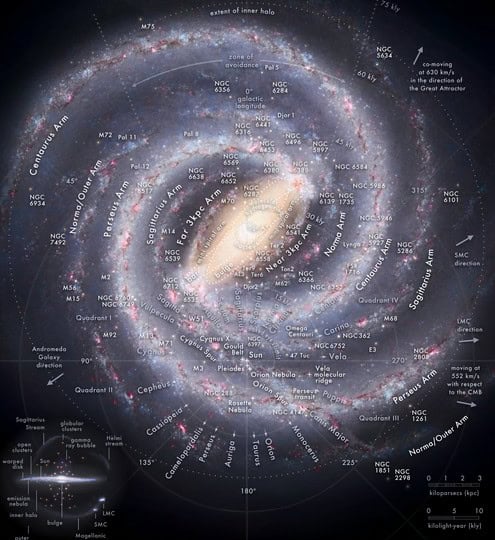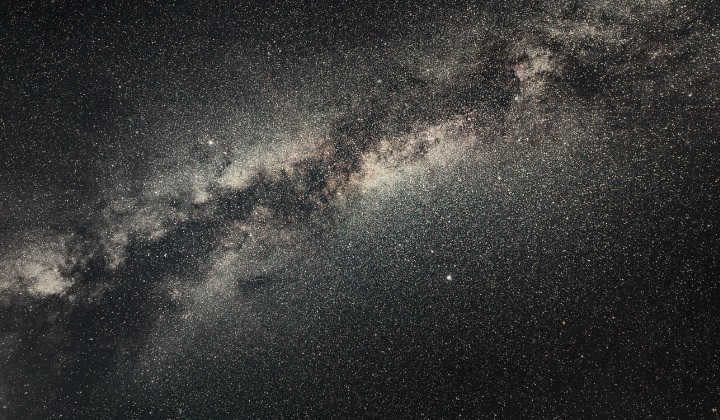
Galaxies are enormous groups of stars, interstellar gas, and cosmic dust. Each one contains millions to trillions of stars. When you observe the most distant galaxies with a regular telescope, they appear as hazy luminous spots.
There are three primary categories of galaxies in the Universe – elliptical-shaped galaxies, spiral galaxies, and irregularly shaped galaxies. The name of our galaxy is the Milky Way.
In the early 17th century, Galileo Galilei peered through a telescope he constructed and made a remarkable discovery. He found that the Milky Way, which can be observed with the naked eye in the night sky, is comprised of an immense number of stars.
Scientists have determined that the visible part of the galaxy from Earth, which encompasses our Sun, is known as the Milky Way galaxy. However, what is the actual appearance of the Milky Way galaxy?
Attempting to answer this question is comparable to trying to ascertain the shape of a house without stepping foot outside of it. It was only in the 20th century that it was discovered that our galaxy takes the form of a flat spiral, with the Sun situated on one of its branches.
The Robinsons on Star Island
Just a quick glance at the celestial sky is sufficient to confirm that the number of stars in every direction is roughly the same on average. However, the presence of the Milky Way disrupts this harmony of celestial bodies and raises intriguing questions. It is through exploring these questions that humanity took its first step towards understanding the vastness of the universe.
Using only our naked eyes, we can only see the stars that are closest to us, the ones in our cosmic neighborhood. However, with the invention of telescopes, astronomers discovered that the Milky Way is composed of numerous faint and therefore distant stars. As we approach this “celestial river,” the number of stars rapidly increases, revealing the true extent of the universe’s vastness.
Like all other galaxies known to astronomers, our Milky Way has indistinct boundaries, making it difficult to determine where it ends and intergalactic space begins.
While the galaxy may appear a certain size when observed through an optical telescope, radio measurements reveal that it is surrounded by enormous clouds of interstellar gas.
However, the primary inhabitants of the Milky Way are stars. There are approximately 200 billion stars in our galaxy, ranging in size, behavior, and formation. These stars are constantly being born, living, and dying, a process that has been ongoing for the past 13 billion years.
From the Fringes to the Heart
Astronomers posit that the Milky Way has an average diameter of 100 thousand light years, hosting a staggering 200 billion stars.
Encompassing the outer reaches of the Galaxy is a virtually imperceptible entity known as the halo, comprised of scorching gas, individual stars, and globular clusters housing the oldest stars, whose age is on par with that of the galaxy itself – approximately 12 billion years.
Nestled within the halo, the galactic disk revolves around the same center, teeming with billions of younger stars and abundant gas-dust clouds where new stars are being born. Additionally, the disk’s matter is considerably more enriched with heavy elements compared to the halo.
In the core lies the nucleus, with its stars creating a “bulge” within the galactic disk – this phenomenon is known as the “balge” by astronomers. The stellar population in this region is incredibly dense, and if our planet Earth were positioned here, the nighttime sky would shimmer with dozens of stars, shining as brightly as the full Moon.
Furthermore, at the heart of our Galaxy resides a supermassive black hole, whose gravitational pull causes the stars in this vicinity to travel along unconventional paths.
The ritual of cannibal dance
The vast distances between galaxies in the Universe are multiple times larger than the sizes of the individual galaxies themselves. As a result, the majority of galaxies exist completely independently, without any mutual influence.
However, unlike stars, galaxies have a higher likelihood of colliding with each other. In fact, galactic collisions occur quite frequently. Nevertheless, such collisions do not lead to the demise of the galaxies, as a galaxy is a collection of stars that are separated by massive distances.
When two galaxies come into close proximity, they primarily affect each other through their gravitational fields. This interaction is known as tidal interaction, which bears resemblance to the way nearby celestial bodies influence the tides in our oceans.
Occasionally, these intricate processes result in a galaxy being devoured by one of its counterparts – astronomers refer to these occurrences as “galactic cannibalism.”
Clarity on Kinship
The majority of interacting galaxies are not haphazardly encountered star systems in space; rather, they are “relatives” connected by their shared origins and positions in the Universe.
As they draw nearer to each other, diverge, or partially merge, these galaxies influence one another and give rise to stunning cosmic structures that are both beautiful and complex.
One notable example of such interaction is the Whirlpool Galaxy in the constellation Canes Venatici. It consists of elliptical and spiral galaxies linked by a bridge of stars, which allows matter to gradually flow into the larger member of the pair.
There is a distant pair of galaxies, with a “bridge” extending between them that measures 230 thousand light years in length and 6 thousand light years in width.
Equally interesting are the galaxies called “Mouse” – both of them have “tails” of stars and interstellar gas stretching for 9 thousand light years.
In 2006, astronomers were able to capture a real cosmic “argument” in the South Pisces constellation. These two galaxies, located 100 million light years away from Earth, are literally tearing apart their gravitational fields.
"Galactic Adhesive"
A new revelation has emerged in the investigation of the rotational patterns of spiral galaxies, including our very own Milky Way.
Under the assumption that the entirety of a galaxy’s mass is concentrated within the matter that becomes apparent through its radiation – such as stars, interstellar gas, and dust – the velocities of stars orbiting the galactic center should decrease as the distance from the center of rotation increases.
However, contrary to this expectation, the angular velocities of stars not only fail to decrease, but in certain cases, actually increase.
Such an extraordinary phenomenon can only be explained if there exists a supermassive halo of matter surrounding the galaxy in the form of a ring or torus. This halo, which emits no detectable radiation and therefore remains invisible, serves as a sort of glue, binding the galactic components together.
Just like galaxy clusters, the presence of “hidden mass” holds stars together in galaxies, preventing them from dispersing. Calculations have shown that the combined mass of stars and interstellar gas is insufficient for this.
Creating galaxies
Interestingly, attempts to categorize galaxies based on their external features began long before the discovery of galaxies themselves.
In 1845, William Parsons, an Irish astronomer and president of the Royal Society of London, proposed the first classification system for spiral nebulae, which were then believed to be part of the Milky Way.
However, it was not until the 1920s that E. Hubble, while observing numerous galaxy images through the Maun-Wilson Observatory telescope, made the observation that certain galaxies exhibited similar characteristics and shared structural features.
In 1926, the astronomer put forth a classification system that categorized galaxies according to their shape, a system that is still utilized today with certain modifications.
This system has been given the nickname “Hubble’s Cameron” by other astronomers. The arrangement of the Hubble classification, in fact, resembles a tool used to adjust musical instruments.
“The Hubble Chamberlain, also known as the Hubble Sequence, set the standard for statistical research on deep space throughout the 20th century.
Differences in the structure of galaxies, according to the renowned astronomer, allow us to categorize them into three main classes.
[1]. Elliptical galaxies (they are designated by the letter “E” and appear as round or elliptical spots in the sky, with their brightness decreasing from the center to the edges. The number added to the letter designation is called the “flattening index”.
An elliptical galaxy classified as E0 is nearly spherical in shape, while an E5 galaxy has a longer minor semi-axis compared to its major semi-axis, giving it an elongated appearance similar to a vegetable. There are a total of seven subclasses ranging from 0 to 6. Elliptical galaxies predominantly contain old stars and have minimal interstellar gas.
[2]. The subsequent category comprises spiral galaxies such as our own Milky Way. These galaxies consist of a flattened disk composed of stars and gas, with a central bulge that has a rounded shape. The disk exhibits prominent spiral arms consisting of young stars, gas, and dust.
Hubble divided all known spiral galaxies into two types based on the number of arms: normal spirals (designated as B) and spirals with a central bar (SB), which can have anywhere from one to ten arms. In normal spirals, the arms originate from the central core and extend outward for one complete revolution.
In bar galaxies, the arms extend perpendicular to the ends of the jumper and typically number no more than two. The density or blurriness of the spiral arms determines their classification into subclasses a, b, and c.
Clearly, bar galaxies are a subset of spiral galaxies and can be further classified based on the visibility of their arms.
Lenticular galaxies occupy an intermediate position between elliptical and spiral galaxies and are denoted by the symbol S0.
[3]. The final category in the Hubble sequence consists of irregular or irregular galaxies (I). These galaxies lack a distinct shape and any specific structural features such as disks, arms, or lintels.
Their uniqueness lies in a different manner: in irregular galaxies, there is always an abundance of interstellar gas, and new star formation processes are always occurring. The Magellanic Clouds, for instance, belong to this category.
The Invasion of the Hobbits
Even after the widespread acceptance of the Hubble classification, astronomers discovered small galaxies that did not fit into any of the identified classes – these are known as dwarf galaxies, or hobbit galaxies.
They lack a definitive shape and consist of only a few billion stars, which is two orders of magnitude smaller than the massive spiral galaxies. The first letter in their names always corresponds to the letter “d” from the English word dwarf.
Exploring Beyond our Galaxy
As astronomers continue to investigate the vastness of the Universe, they have progressively delved deeper into its enigmatic depths. After comprehending and elucidating the structure of our own solar system, scientists turned their attention to the Milky Way – an immense “corporation” of stars and interstellar matter, governed by unique and not yet fully understood “laws”.
However, the subsequent phase – the identification and examination of other “celestial archipelagos”, both resembling and differing from our own – proved to be extraordinarily challenging. This endeavor entailed grappling with distances spanning hundreds of thousands and millions of light years!
Even in the early decades of the 20th century, not all astronomers subscribed to the notion of stars and stellar systems existing beyond our Galaxy.
With the emergence of advanced next-generation telescopes, it became possible to measure the distances to distant nebulae and demonstrate that they are thousands of times more distant than the furthest “shores” of our “starry island.”
Consequently, a new field of science was born – extragalactic astronomy. Its objectives are truly ambitious: to explore the fundamental properties of the observed portion of the Universe – the Metagalaxy – and to develop a comprehensive theory of its origin and evolution.
Existing theories and established physical laws proved insufficient for this task, as they cannot adequately describe the states of matter and phenomena that occur at extreme values of density, temperature, and pressure.
To approach the development of a theory of this nature, we required observational data from regions of the Universe that are billions of light years distant from our own.
To acquire this data, it was imperative to devise ultra-precise instruments and unconventional research methodologies.
Thus, the major breakthroughs in extragalactic astronomy are intertwined with the emergence of the computer era and novel advancements in quantum physics.
Aggregates of Aggregates
A galaxy is an immense aggregate, a “collective” of stars that are bound together by the forces of gravitational interaction. However, the observations conducted by astronomers reveal the existence of “aggregates of aggregates” – systems of galaxies that are bound together by gravity.
These structures are likely to be some of the largest in the Universe, with their size potentially reaching hundreds of millions of light-years.
Clusters of galaxies are not evenly distributed in the observable part of the Universe, instead forming a spatial network where denser regions alternate with vast voids.
The existence of clusters of galaxies that lead a “shared life” is suggested by astrophotography.
Witnesses from Different Eras
Globular clusters, which are clusters of a different type, have a distinct appearance. They resemble a swarm of insects, all striving towards their desired prey. As you move closer to the center of the cluster, the stars become larger and more numerous.
When observed through a telescope, the stars in the central regions of globular clusters seem to blend together, even though their actual distances from each other are quite significant.
All of the stars in globular clusters have an age comparable to that of our Milky Way Galaxy, which is approximately 10 billion years. These stars are composed of a mixture of hydrogen and helium, lacking heavy elements. This composition leads astronomers to classify them as some of the oldest “inhabitants” of the Milky Way.
While studying globular clusters, American astronomer H. Shepley (1885-1972) proposed that the center of our Galaxy is located in the direction of the Sagittarius constellation, and that globular clusters represent the oldest component of the Galaxy, predating the rotation of the Milky Way.
In this way, H. Shepley, much like Copernicus “stripped” the Earth of its central position in the solar system, stripped the solar system of its central position in the galaxy.
The Trio of Spiral Galaxies
In the Local Group, there exist only three prominent spiral galaxies – the Milky Way, the Andromeda Galaxy, and the smaller M33 galaxy located in the Triangle constellation.
Accompanying these three galaxies are numerous irregular and dwarf galaxies, as well as companion galaxies and star clusters. The smaller galaxies appear to be concentrated around the two largest ones.
The “family” of the Milky Way includes the colossal spiral galaxy itself, along with 14 of its satellites. This collection encompasses the irregular galaxies known as the Large and Small Magellanic Clouds, as well as dwarf galaxies situated in the Sculptor, Kiel, and Furnace constellations. Additionally, there is a dwarf elliptical galaxy in the Sagittarius constellation, along with several others.
The Andromeda group is similar to the Milky Way group: at its core is the Andromeda galaxy, surrounded by 18 satellite galaxies, including irregular and elliptical star systems.
The spiral galaxy in the Triangle constellation also has associated “dwarfs”, but their exact motion has yet to be determined.
The Atlantic Ocean: located between four continents
What is the definition of being bilingual?
Beacons in the Universe
What causes “growth sickness”?
The hardworking “hipparcos”.
- Australia and Oceania (40)
- Asia (30)
- America (59)
- Antarctica (15)
- Africa (26)
- Household appliances (35)
- Time (25)
- Dinosaurs (16)
- Europe (28)
- Mix (43)
- Internet and Computers (19)
- History and Archaeology (25)
- Space (285)
- Animal World (158)
- My Planet (134)
- Science and Technology (120)
- Society (60)
- Nature (160)
- Psychology (104)
- Agriculture (17)
- Tigers (26)
- Humans (131)
- Ecology (24)

The franchise known as Guardians of the Galaxy consists of a collection of films that chronicle the exciting exploits of a group dedicated to protecting the universe. These films are part of the Marvel Cinematic Universe, which is based on the popular Marvel Comics series.
Within this franchise, the heroes are a diverse group of individuals who share a common passion for adventure and a deep-seated commitment to safeguarding the world. Each character possesses their own unique backstory and possesses extraordinary powers that aid them in their battles against formidable adversaries. Here is a comprehensive list of all the Guardians of the Galaxy movies in sequence.

Director: James Gunn
Cast: Chris Pratt, Zoe Saldana, Dave Batista, Michael Rooker, John C. Reilly, Djimon Hounsou, Glenn Close, Lee Pace, Karen Gillan, Laura Haddock, Benicio Del Toro, Solomon Moseley, Wyatt Oleff, Marama Corlette, Josh Brolin.
The reunion of the future Guardians of the Galaxy occurred within the confines of a penitentiary. Adventurer Peter Quill, known as Star Lord, successfully pilfered an orb that belonged to the power-hungry antagonist Ronan, who harbored plans of universal domination.
While attempting to sell the acquired artifact, Star Lord encountered a group of bounty hunters. The initial encounter between the prospective heroes did not go smoothly. Words quickly escalated into physical altercations, resulting in their collective incarceration in an interstellar prison. In order to escape, this diverse group had to unite their efforts.
Guardians of the Galaxy: Volume 2 (2017)

Directed by James Gunn
Starring: Chris Pratt, Zoe Saldana, Dave Batista, Kurt Russell, Pom Klementieff, Karen Gillan, Chris Sullivan, Sylvester Stallone, Elizabeth Debicki, Nathan Fillion, Michael Rooker, Tommy Flanagan, Glenn Close, Aaron Swartz, Sean Gunn, Wyatt Oleff
The entire team of Guardians of the Galaxy is present. Star Lord, Rocket the raccoon, Groot the living tree, Drax the thug, and Gamora the green-skinned continue to find themselves in unimaginable situations, but somehow manage to escape with minimal damage to the environment.
This time, the heroes must unravel one of the universe’s greatest mysteries and discover the true identity of Star Lord’s father.
This chapter of the Guardians of the Galaxy’s adventures provides answers to many questions that arise while watching the first part.
Avengers: Infinity War (2018)
can be paraphrased as
Avengers: Infinity War (2018)
is a movie that was released in 2018.

Directors: Joe Russo, Anthony Russo
Actors: Chris Evans, Robert Downey Jr, Scarlett Johansson, Elizabeth Olsen, Chris Hemsworth, Sebastian Stan, Chris Pratt, Zoe Saldana, Benedict Cumberbatch, Pom Klementieff, Karen Gillan, Tessa Thompson, Benicio Del Toro, Linda Cardellini, Tom Hiddleston, Tom Holland, Josh Brolin, Paul Bettany, Cobie Smulders, Jon Favreau
As the Avengers and their allies join forces to protect the world from various threats, they face the emergence of Thanos, an intergalactic dictator determined to gather all six Infinity Stones in order to carry out a diabolical plan for global domination.
The future of the world becomes highly uncertain. People from all walks of life are rallying to fight. The Guardians of the Galaxy receive an urgent distress signal from a ship belonging to the Asgardians and set a course for it. Unexpectedly, their own ship is struck by Thor, who is unconscious.
He informs them that Thanos has decimated Xandar and acquired the power stone, and is now en route to Oblivion in pursuit of the reality stone. Determined to stop him at any cost, the Guardians of the Galaxy make a firm decision.
Avengers: The Ultimate Journey (2019)

Joe Russo and Anthony Russo directed: Chris Evans, Robert Downey Jr., Scarlett Johansson, Chris Hemsworth, Karen Gillan, Josh Brolin, Paul Rudd, Evangeline Lilly, Michelle Pfeiffer, Brie Larson, Dave Batista, Sebastian Stan, Jeremy Renner, Chadwick Boseman, Gwyneth Paltrow, Mark Ruffalo, Ty Simpkins, Jon Favreau, Hiroyuki Sanada, and Don Cheadle starred in this movie.
This particular installment of the franchise proved to be the most intricate and perplexing. The utilization of the most cutting-edge concept of time travel was implemented, an idea that many professors believed was much more fitting for the demands of physics. Nevertheless, comprehending the concept is not a simple task.
It has been discovered that it is possible to terminate oneself in the past without creating a time paradox. Furthermore, there is no such thing as the “butterfly effect”. Nebula switches sides and eliminates a previous version of herself in order to prevent her from surrendering the infinity gauntlet to Thanos.
Gamora’s destiny remains uncertain, although the storyline suggests that her journey will persist in the third installment. Thor becomes a member of the guardians and immediately starts vying for leadership with the current leader, Peter Quill.
Thor: Love and Thunder (2022)
Thor: Love and Thunder (2022) is an upcoming film that fans of the Marvel Cinematic Universe are eagerly anticipating. This highly anticipated movie is set to be a sequel to the popular 2017 film Thor: Ragnarok. Directed by Taika Waititi, Thor: Love and Thunder promises to bring back the beloved characters from the previous film, including Thor (played by Chris Hemsworth), Loki (played by Tom Hiddleston), and Valkyrie (played by Tessa Thompson). The film also introduces new characters, such as Jane Foster (played by Natalie Portman), who will take on the mantle of Thor in this installment. With an exciting plot and a star-studded cast, Thor: Love and Thunder is sure to be a must-see film for Marvel fans.

Directed by.: Taika Waititi
Actors: Chris Hemsworth, Tessa Thompson, Natalie Portman, Kevin Feige, Karen Gillan, Taika Waititi, Christian Bale, Matt Damon, Chris Pratt, Russell Crowe, Melissa McCarthy, Jaimie Alexander, Sam Neill, Bradley Cooper, Pom Klementieff, Dave Batista, Sean Gunn, Luke Hemsworth, Mark Casimir Dinevich, Jason Jago, Jason Jago, and Mark Dinevich.
Following the events of the previous film, Thor continues his journey alongside the Guardians of the Galaxy, triumphantly defeating adversaries and leaving destruction in his wake. However, everything changes when he receives a distress signal from the goddess Sif, whose planet is under attack by Gorr.
Sif reveals that Gorr’s next target is New Asgard. Upon receiving this alarming news, Thor parts ways with the Guardians of the Galaxy and sets off to aid the Asgardians.
In this installment of the Thor franchise, the character is portrayed in a more nuanced manner compared to his fiery and conquering persona in the initial film. Love and acceptance are key themes explored in this iteration, which serve to humanize and soften the image of the traditionally warlike God.
The Guardians of the Galaxy: Holiday Special in 2022

James Gunn directed the movie.
The cast includes Chris Pratt, Dave Batista, Pom Klementieff, Karen Gillan, Zoe Saldana, Sean Gunn, Kevin Bacon, Michael Rooker, David Moskovitz, Stephen Blackhart.
The story centers around the holiday preparations of the Guardians of the Galaxy. The team learns from Kraglin Obfonteri about how Yondu Udonta ruined Star-Lord’s Christmas when he was a kid.
Mantis and Drax go on a journey to Earth in search of the perfect present for Peter and to save the holiday for him. They come across Peter’s childhood idol, Kevin Bacon, only to realize that he is just an actor and not a real hero.
Guardians of the Galaxy: Part Three (2023)

Director: James Gunn
Cast: Chris Pratt, Zoe Saldana, Dave Batista, Karen Gillan, Pom Klementieff, Elizabeth Debicki, Sean Gunn, Sylvester Stallone, Will Poulter, Chakwudi Iwuji, Daniela Melchior, Michael Rosenbaum, Nico Santos, Stephen Blackhart, Sung Gun, Sarah Ann.
The release date for the worldwide distribution of this film is set for May 5, 2023. This marks the culmination of the series that follows the adventures of Peter Quill, a noble and daring leader of a group of universe defenders. Once again, this team of heroes will come together to save the world.
The fate of Gamora remains uncertain, but it is anticipated that she will make an appearance in the film as a different version from a previous timeline. While Thor joined the Guardians of the Galaxy in the last Avengers movie, there is no confirmation of his presence in the final installment of Guardians.
In early 2022, director James Gunn expressed his desire to provide audiences with a satisfying conclusion to the story. The last chapter of Guardians of the Galaxy is expected to be an extraordinary experience.
- List of films featuring Hulk
- List of movies starring Iron Man
- List of Spider-Man films
- List of Thor movies
- List of Doctor Strange movies
- List of Captain America films
- List of movies about Black Widow
- List of Black Panther films
- List of Ant-Man movies
- List of Superman films
- List of Batman films
- List of Wonder Woman movies
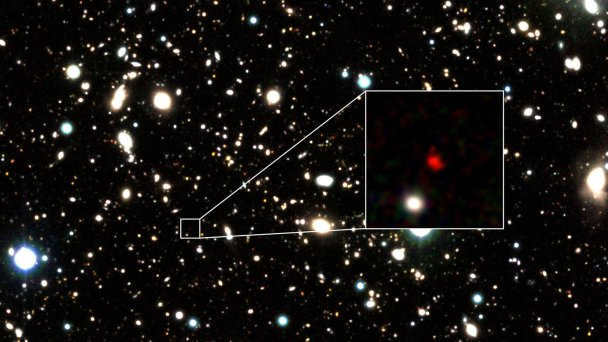
Researchers from Japan, the United Kingdom, the Netherlands, and the United States have made a remarkable discovery – a galaxy located at an unprecedented distance from Earth. The light emitted by this galaxy has traveled for over 13 billion years before reaching our telescopes, allowing us to observe it as it appeared a mere 300 million years after the occurrence of the Big Bang. This extraordinary finding suggests that the light we are now observing could potentially be originating from the oldest stars in the Universe, which have never been observed by astronomers until now.
The Big Bang: myths and truths
In order to highlight the significance of observing the most distant galaxies, it is important to delve into the origins of the observable universe.
Misconceptions surrounding the Big Bang and the expansion of the Universe often arise among individuals who are not well-versed in astronomy. They mistakenly believe that space did not exist at all or that it was condensed into a single point. According to this misconception, the Big Bang then occurred at that point, initiating the expansion of space. These misunderstandings are often perpetuated by the popular analogy of the Universe as an inflating balloon.
Although it is true that the Big Bang marks the commencement of the Universe’s expansion, it did not originate from a single point like a balloon inflating from its center. Instead, the expansion initiated simultaneously in all regions of space. To envision this, picture space as a stretchable tablecloth. When pulled from all sides, the tablecloth stretches or expands. However, even before the expansion begins, the tablecloth was already extended and not compressed into a single point. Nevertheless, the expansion does cause the distance between any two points to increase: a line drawn on the tablecloth with a marker grows longer and longer.
Undoubtedly, the boundaries of physical space are virtually non-existent, and the expansion is not a result of external forces acting upon it. In actuality, it is highly likely that the fabric of the cosmos is infinite (although this cannot be definitively proven). Furthermore, if it is indeed infinite, it would have been so prior to the occurrence of the Big Bang. Subsequent to the Big Bang, space has undergone expansion, although the magnitude of this expansion is immense, it remains finite.
It is important to note that the pre-Big Bang world was vastly dissimilar. While it did possess certain fields and particles, it lacked even the presence of protons and atoms, not to mention celestial bodies such as stars and planets. In this regard, the Big Bang can be regarded as the genesis of the Universe, or more precisely, the Universe as we currently comprehend it.
The occurrence of the Big Bang took place approximately 13.8 billion years back in time. In the initial sixty seconds, the process of atomic nuclei formation commenced. After hundreds of thousands of years had passed, these nuclei merged with electrons to create atoms. It took hundreds of millions of years for the light emanating from the earliest stars to brighten up the entirety of the cosmos.
The formation of major galaxies, including our own, occurred shortly after the Big Bang, making them nearly the same age as the Universe. However, the cosmos has undergone significant changes over billions of years. Galaxies have grown by colliding and merging with one another. The initial generation of stars eventually died out, dispersing matter into their surroundings through thermonuclear reactions. From the remnants, a second generation of stars emerged. After these stars burned out, they became the building blocks for the third generation of stars, which includes our Sun. Reconstructing the past of the Universe based on its present state is a challenging task, much like determining the composition of continents, oceans, and mountain ranges that existed on Earth billions of years before the arrival of humans.
Thankfully, astronomers possess the secret to journeying through time. It lies within the vast expanses that separate galaxies. When light from a far-off star system requires 13 billion years to reach us, we perceive it as it appeared 13 billion years ago. This is precisely why “space archaeologists” strive to observe objects that are as distant as feasibly possible.
Unstable Distances
It is a known fact that differentiating between a faraway celestial object and a nearby one can be quite challenging. When observed through a telescope, most galaxies appear as hazy spots, making it difficult to determine why one appears brighter than another. Is it because it is closer or because it emits more light? However, there is a solution.
This solution is based on the principle that light is a form of electromagnetic radiation. Each type of electromagnetic wave has a unique wavelength, which is the distance between adjacent crests. In the case of light, its wavelength ranges from 400 nanometers (violet light) to 800 nanometers (red light). Additionally, there are wavelengths that are shorter than light, such as ultraviolet, X-rays, and the shortest of them all, gamma rays. On the other hand, there are longer wavelengths than light, including infrared and radio waves.
By separating the light of a celestial object into a spectrum, which means “arranging” it according to wavelengths, we can gain insight into the extent to which it has been stretched during its journey as a result of the Universe’s expansion. The term used to describe this phenomenon is redshift, represented by the letter z.
By knowing the redshift, it becomes possible to calculate the duration of time that light has been traveling, and consequently determine the distance to the object. However, the straightforward rule “the time it takes for light to travel in years is equal to the distance in light-years” no longer applies when dealing with such vast distances. The intricate relationship between space, time, and gravity compels scientists to redefine the very notion of distance and differentiate between radial, concomitant, and other types of distances. Consequently, it is suddenly realized that the light from a distant galaxy has covered 13 billion light years in one sense, 30 billion in another sense, and even 270 billion in yet another sense over a span of 13 billion years.
To avoid confusing the reader, we will henceforth discuss the duration of light travel instead of the distance. Experts, in fact, do not rely on redshift in their calculations. An astronomer might exclaim, “I observed an object with z=13,” leaving his colleagues in awe.
An encounter with a time-traveler
In a groundbreaking discovery, researchers have stumbled upon a pair of galaxies boasting an extraordinary redshift value ranging between 12 and 13. This remarkable finding implies that the light emitted by these celestial bodies originated a mere 330 to 380 million years after the cataclysmic event known as the Big Bang. In a nod to scientific simplicity, astronomers have aptly designated these enigmatic entities as HD1 and HD2.
However, the ALMA radio telescope was used by astronomers to determine the redshift of HD1 (no information was given about the redshift of HD2). The redshift was found to be 13.27, indicating that the light was emitted just 330 million years after the Big Bang and spent nearly 13.5 billion years traveling. This sets a new record for any celestial object and provides a unique glimpse into the distant past of the universe.
Several of the astronomers who discovered HD1 and HD2 have already published a preprint of another scientific paper. In this paper, experts have attempted to understand the nature of the radiation emitted by these “goddaughters”.
The light and infrared waves that reached the Earth’s telescopes were once ultraviolet rays, but they ceased to be so due to the expansion of the universe. The question is what caused the production of these rays.
Maybe the radiation is produced by material collapsing onto an incredibly massive black hole, equivalent to hundreds of millions of suns. Essentially, HD1 and HD2 are quasars. If this is the case, it’s fascinating that these “predators” have already formed in such ancient epochs. This early development would strongly challenge theories that attempt to explain the formation of supermassive black holes.

At present, there are exclusive discounts ranging from 2% to 25% available to a total of 58,743 educational institutions. To determine the specific discount applicable to all staff members of your educational institution, simply sign in to your personal Infoworks account.




Advanced training program
Expert in occupational safety
We can apply your institution’s discount to this offer (the amount of the discount depends on the number of your colleagues who have completed Infowork courses).
Currently, there are 58,743 eligible educational institutions that can receive additional discounts (ranging from 2% to 25%). To find out the exact discount applicable to all employees of your institution, please log in to your personal Infoworks account.


Professional Retraining Course
Organization of librarian activity in professional education
In addition to this discount, you may also be eligible for a discount from your educational institution, depending on how many of your colleagues have taken Infoworks courses.
Currently, there are 58,743 educational institutions that offer additional discounts ranging from 2% to 25%. To determine the discount available for all employees of your educational institution, please log in to your personal Infoworks account.




Creating a personal brand through publishing and media engagement
Breakdown of the presentation by individual slides:

On the second slide, let’s delve into the fascinating history of galaxy classification. It all began in 1925 when Edwin Powell Hubble, an esteemed American astronomer, formulated the initial classification system. This groundbreaking system was so effective that it continues to be utilized by astronomers worldwide to this day, with only slight adjustments made by Hubble himself in 1936.


Slide 3: The classification of galaxies suggested by Hubble is frequently referred to as the cameraton classification due to its resemblance to the forked shape of a tuning fork. According to this classification system, galaxies are categorized into five primary types:
– elliptical (E);
– lenticular (SO);
– regular spiral (S);
– barred spiral (SB);
– irregular (I).
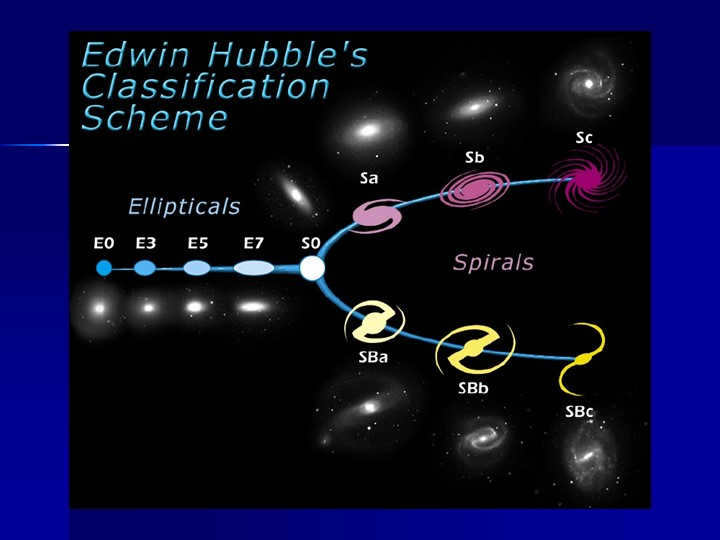

Slide 5: Elliptical galaxies
Elliptical galaxies account for 25% of all galaxies. They have a fuzzy circular or elliptical shape, with their brightness decreasing rapidly from the center to the outer edges. Elliptical galaxies come in various shapes, ranging from globular to highly flattened. They are classified into 8 subclasses, from E0 (globular shape, no compression) to E7 (highest compression).
In terms of structure, elliptical galaxies are the simplest. They primarily consist of old stars and contain very little cold gas or cosmic dust. The most massive elliptical galaxies are filled with highly rarefied hot gas, with temperatures exceeding 1,000,000 K, giving them a reddish color. Only the most compressed elliptical galaxies exhibit rotation. An example of an elliptical galaxy is the one found in the Virgo constellation.
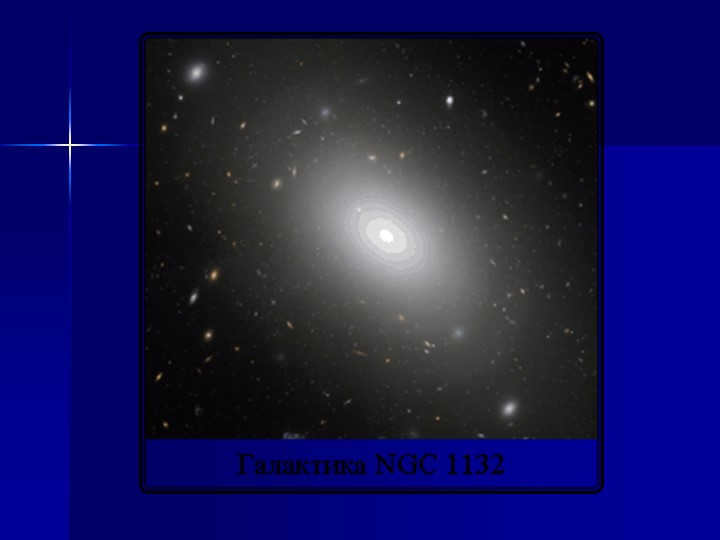
There are 7 slides about spiral galaxies. Spiral galaxies are responsible for around 50% of all observed galaxies. The majority of stars within a galaxy are located in a lens-shaped area known as the galactic disk. This disk exhibits a spiral pattern, with two or more branches or arms twisting to one side and emerging from the center of the galaxy. There are two distinct types of spiral galaxies. The first type, labeled SA or S, features spiral branches that directly emerge from the central core. The second type begins at the ends of an elongated structure with an oval core at its center. These galaxies appear to have two spiral branches connected by a bridge, earning them the name “crossed spirals” and the designation SB.


When it comes to spiral galaxies, their spiral structure development can vary. This difference is noted in the classification system by adding the letters a, b, c to the symbols S (or SA) and SB.
In galaxies classified as Sa and SBa, the majority of stars are concentrated in the central cluster, with the spiral branches being weakly expressed or only outlined. On the other hand, galaxies classified as Sb and SBb have more developed branches. In the case of Sc and SBc galaxies, the main concentration of stars can be found in strongly developed and often scattered branches, while the central thickening is minimal.

Slide 9: The reason why the arms of spiral galaxies appear blue is due to their high concentration of young giant stars. These stars emit light that causes the diffuse gas nebulae and dust clouds along the spiral branches to glow. The central clumps of these galaxies, on the other hand, have a reddish-yellow hue, indicating that they are primarily composed of stars belonging to the G, K, and M spectral classes. The narrow disk of spiral galaxies, where stars, dust, and gases are concentrated, is a result of their significant rotational velocities. This disk is also characterized by an abundance of gas and dust clouds, as well as the presence of bright blue giants belonging to the O and B spectral classes, which suggests that active star formation processes are occurring in the spiral arms of these galaxies.

Slide 10: The disk of spiral galaxies is surrounded by a sparsely populated, dimly glowing collection of stars known as the halo. In certain galaxies, the inner region takes on a spherical shape and emits a strong luminosity.
This region is referred to as a bulge. In other galaxies, the central region of the galaxy forms a “stellar lintel” – a bar-like structure. In some nuclei, apart from stars, there is a brilliant star-like source at the center and luminous gas that moves at speeds of thousands of kilometers per second. These types of galaxies are known as galaxies with active nuclei, or Seyfert galaxies.
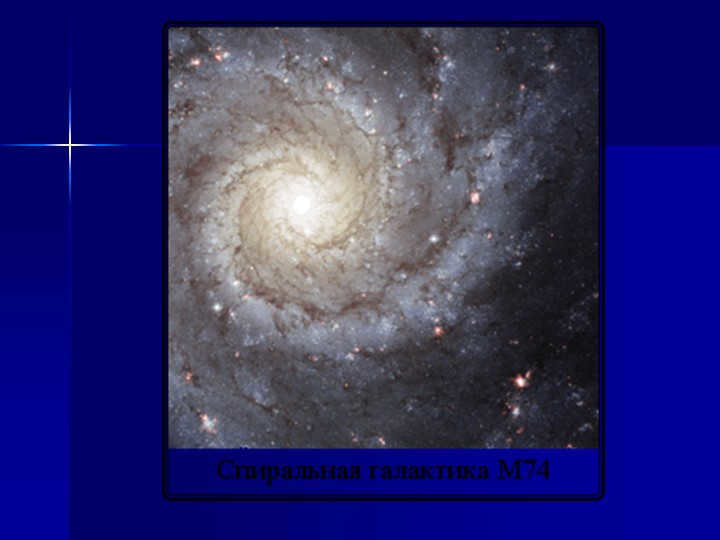
Slide 12 Lenticular galaxies
A lenticular galaxy of type SB0 is an intermediate type that lies between spiral and elliptical galaxies. In this type of galaxy, the bright central cluster (balge) is compressed and shaped like a lens, while the branches are either absent or barely visible.
These galaxies are made up of old, massive stars, giving them a reddish color.
Similar to elliptical galaxies, two-thirds of lenticular galaxies do not contain any gas, while one-third have the same amount of gas as spiral galaxies.
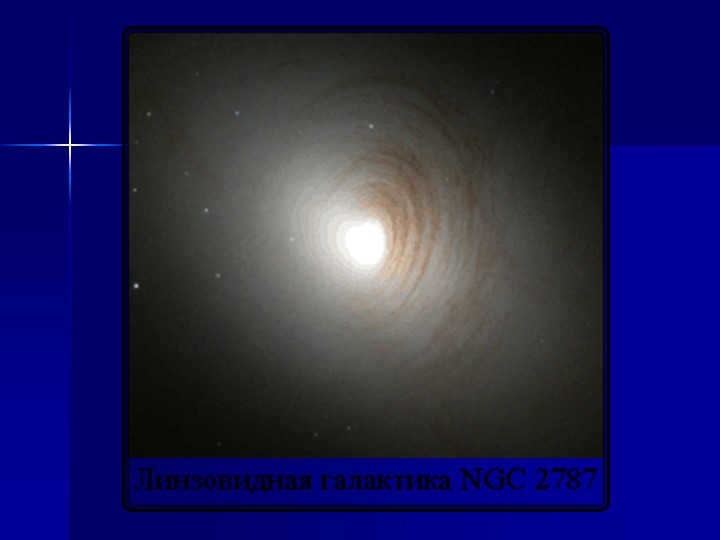
There are 14 slides dedicated to irregular galaxies. Irregular galaxies are characterized by their irregular appearance, lacking a nucleus and any overall structure. These galaxies are composed of young stars and contain a significant amount of interstellar gas, making up 10 to 50% of their total mass. Despite their varied characteristics, irregular galaxies can be classified into two main subclasses: galaxies similar to the Large Magellanic Cloud and blue compact galaxies. The former typically have a small nucleus and remnants of spiral arms, often with a junction, resembling spiral galaxies in early stages of evolution.


